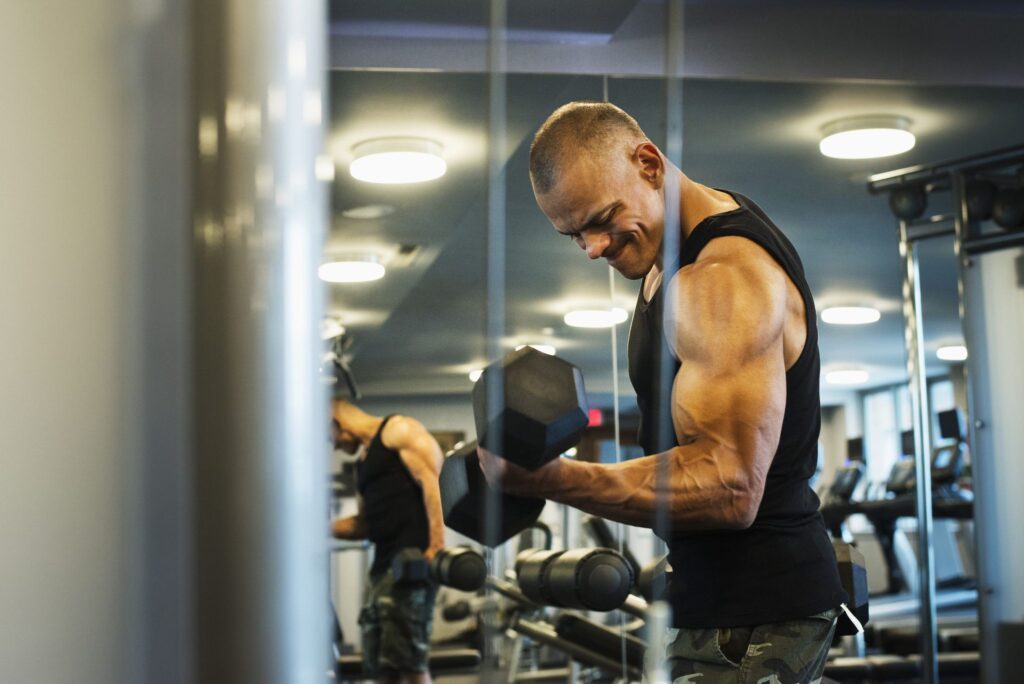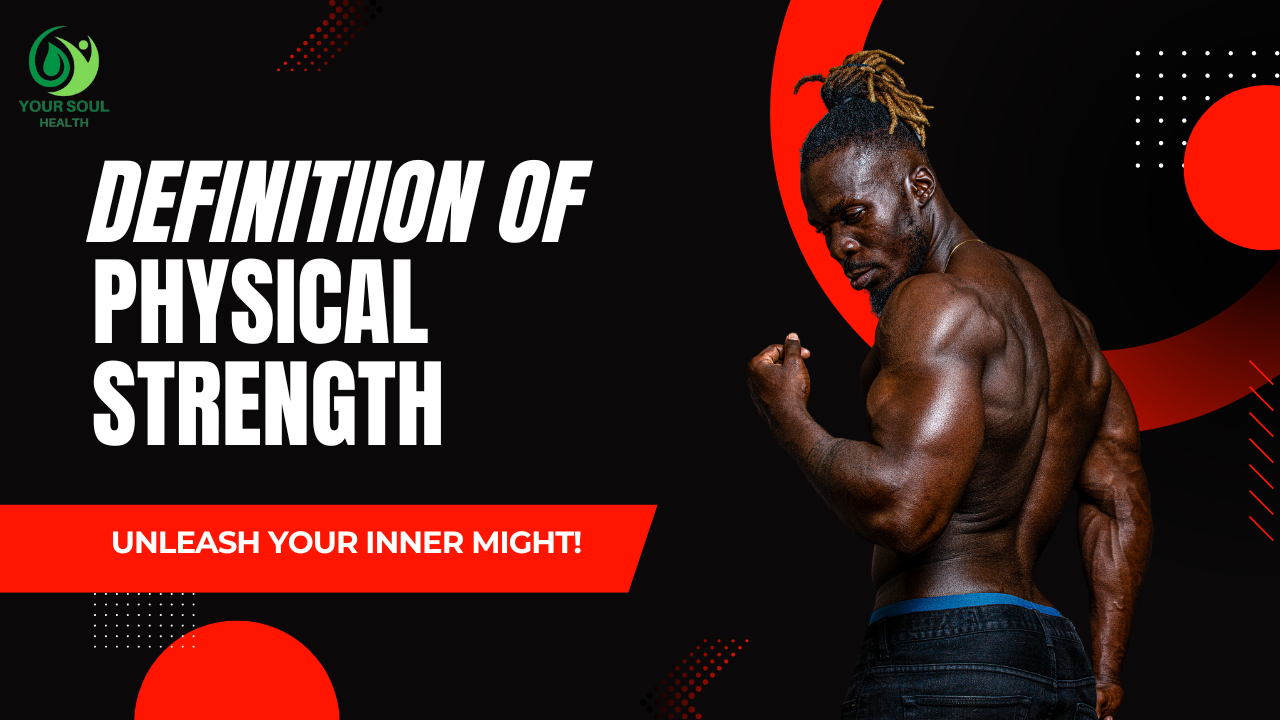Discover the comprehensive definition of physical strength, exploring its components, significance, and how it influences overall health and fitness. Physical strength is the ability of the body to exert force on physical objects. It involves muscular power, endurance, and the capacity to perform tasks.
Embracing physical strength is vital for various everyday activities, from lifting groceries to rigorous athletic performance. Enhancing one’s physical strength leads to better health, higher stamina, and improved overall wellbeing. Proper exercise, nutrition, and rest are fundamental in building and maintaining strength.
Engaging in strength training not only fortifies muscles but also strengthens bones and connective tissues, which can prevent injuries and aid in quicker recovery. Individuals seeking to boost their physical strength should aim for a balanced approach that incorporates different types of physical activity to ensure comprehensive muscle development.

Physical Strength Dissected
Dissecting physical strength opens a fascinating window into how our bodies operate at peak performance. This exploration dives deep into the elements that construct our ability to exert force, lifting, pushing, and pulling with power. It’s not just about the size of our muscles. There’s a whole world of biology and practice behind that strength we see.
The Biological Basis
The foundation of physical strength ties back to how muscles, bones, and nerves collaborate. Muscles generate power. Bones provide the structure. Nerves send signals, telling muscles to contract. The interaction among them makes strength possible.
In detail, our muscles contain fiber types geared for various tasks. Slow-twitch fibers maintain activities like standing or walking for lengthy periods. Fast-twitch fibers handle fast, strong movements but tire quickly.
Muscle Mass Vs. Muscular Endurance
Muscle mass and endurance are distinct yet intertwined elements of strength. More mass typically means the ability to generate more force, comparing a heavyweight lifter to a marathon runner.
| Muscle Mass | Muscular Endurance |
|---|---|
| Refers to the size of muscles | Ability to sustain activity |
| Boosts short-burst strength | Supports extended performance |
| Measures in one-rep max | Measures in repetitions over time |
In training, lifting heavy weights typically increases mass. On the opposite end, repeated activity for longer durations builds endurance.

Measuring Might
Physical strength is a measure of muscle power and endurance. It helps us in sports, work, and daily activities. To understand strength levels, experts set benchmarks. These benchmarks help compare, train, and understand human limits.
Common Benchmarks Of Strength
Physical strength varies from person to person. Experts use benchmarks to compare these strengths. These include:
- Weight lifting records: How much a person can lift in exercises like the squat, bench press, or deadlift.
- Fitness tests: Activities like push-ups or sit-ups within a time limit.
- Sport-specific drills: Sprints or jumps show strength for specific sports.
Trainers use these benchmarks to design workouts. They tailor these workouts to individual needs and goals.
Limits Of The Human Body
The human body has amazing strength limits. These limits are:
| Capability | Limit Description |
|---|---|
| Absolute Strength | The maximum force exerted regardless of muscle or body size. |
| Endurance Strength | Ability to sustain a force over time. |
| Explosive Strength | Power to exert force quickly for dynamic movements. |
Records like the world’s heaviest lift are just one way to see human strength limits. Other tests check how long we can hold a force or how quickly we can move.
Gender Differences In Strength
Strength is a human attribute often measured and marveled. But when it comes to men and women, how different is this trait? Our exploration into Gender Differences in Strength will shed light on the varying aspects of strength between genders and the factors that influence them.
Physical Strength refers to the capacity to exert force on physical objects using muscles. It plays a critical role in our daily activities and general health.
Physiological Factors
Science reveals that men and women have inherent physiological differences that affect muscle mass and strength. For example:
- Testosterone levels are significantly higher in men, aiding in muscle growth.
- Women typically have higher fat percentage, which influences their body composition.
- Men often possess greater muscle mass, contributing to raw power.
Societal Perceptions And Reality
While physiology sets a base, society also shapes strength perceptions. We dive into how societal norms impact the physical capabilities of men and women:
| Societal Perception | Reality |
|---|---|
| Men should display more strength than women. | Strength varies greatly among individuals, regardless of gender. |
| Women should focus on non-strength based activities. | Women are capable of developing significant strength through training. |
Exploring these themes not only broadens our understanding but also empowers us to celebrate strength in all its forms, across all genders.
Historical Icons Of Vigor
Historical Icons of Vigor have always sparked wonder and admiration in society. They embody the pinnacle of physical strength, with stories captivating audiences for centuries. From tales of Herculean feats to exhibitions in circus strongman shows, these characters have shaped our understanding of what it means to be powerful. Let’s journey through history to rediscover these paragons of strength.
Legendary Strongmen And Women
Throughout history, certain individuals have risen above the rest to become legendary for their immeasurable strength. These strongmen and women have set records, inspired generations, and left indelible marks on the fitness industry.
- Eugen Sandow: Often called the ‘Father of Bodybuilding’, he wowed early 20th-century audiences with his physique.
- Louis Cyr: A Canadian icon, hailed as the strongest man ever to have lived during his time.
- Katie Sandwina: A circus performer who could lift her husband overhead with one hand.
Cultural Symbols Of Power
Power extends beyond individuals to become a cultural symbol. It’s woven into the fabric of mythology and national identity. Here are some iconic cultural symbols of power:
| Culture | Symbol | Significance |
|---|---|---|
| Greek | Hercules | A demigod renowned for his strength and twelve labors. |
| Norse | Thor | The god of thunder wields a hammer symbolizing might. |
| Chinese | Dragon | A creature representing power and authority. |
Modern Heroes Of Strength
In today’s world, strength isn’t just about muscle power. It’s a blend of physical prowess, dedication, and heart. The modern heroes of strength inspire us, showcasing what the human body can achieve when pushed to its limits. Let’s meet these champions who redefine the meaning of strength in sports and daily life.
Standouts In Strength Sports
The arena of strength sports has always been home to awe-inspiring athletes. Today, it shines with stars who break records and set new standards. Here’s a look at some notable performers pushing the envelope:
- Weightlifters: lift staggering weights with precision.
- Bodybuilders: Sculpting their physiques to perfection.
- Strongman competitors: Showcasing herculean feats.
Their achievements echo in gyms worldwide, motivating countless others to test their own limits.
Unsung Heroes In Everyday Life
Apart from celebrated athletes, there are countless heroes who exhibit strength daily. They do not stand on podiums, yet they deserve our admiration:
- Emergency responders: Rushing to save lives without hesitation.
- Healthcare professionals: Combating illnesses, restoring health.
- Construction workers: Building the backbone of our cities.
These individuals embody true strength, making our communities stronger and safer.
| Athlete | Everyday Hero |
|---|---|
| Record-breaking lifts | Daily life-saving actions |
| Sport-specific training | Skills that protect and serve |
| Global recognition | Local impact |
Whether through sports or service, these heroes of strength demonstrate the vast capabilities of the human spirit. They motivate us to pursue our own strength, physically and mentally. Let’s celebrate their extraordinary contributions to our lives.
:max_bytes(150000):strip_icc()/The-Best-Inner-Thigh-Exercises-of-All-Time-9f19643cf631446c8cb9ac430e166bae.jpg)
Credit: www.shape.com
Strength Training Essentials
Strength Training Essentials form the backbone of building physical prowess. Crafting a powerful physique goes beyond lifting weights; it involves meticulous planning, dedication, and understanding the key elements that contribute to muscular strength. Embrace the fundamentals and witness significant gains as you embark on your strength training journey.
Key Exercises For Building Strength
To enhance physical strength, certain exercises stand out. These movements target multiple muscle groups, promote functional strength, and offer a solid foundation for overall muscle development.
- Squats: Engage legs and core.
- Deadlifts: Build back and leg strength.
- Bench Press: Strengthen the chest, shoulders, and arms.
- Pull-Ups: Develop upper body and grip strength.
- Overhead Press: Work the shoulders and triceps.
These exercises, performed correctly, yield impressive results. Consistency is key. Beginners should start with lighter weights to perfect form.
Program Design Principles
A well-structured program is critical for safe and effective strength training. Follow these principles to maximize your workouts.
- Progressive Overload: Gradually increase the weight to challenge muscles.
- Variety: Alter exercises to prevent plateaus and boredom.
- Recovery: Allow time for muscles to repair and grow.
- Balance: Work all muscle groups for symmetry and injury prevention.
- Consistency: Stick to your routine for best results.
Design your program according to these tenets. Monitor your progress and adjust as needed. Seek professional guidance for tailor-made advice.
Nutrition For Muscle Building
Building muscle is not just about lifting weights; it’s also about what’s on your plate. Proper nutrition plays a crucial role in muscle development and overall physical strength. To achieve the best results, understanding the right balance of foods and nutrients is key. Keep reading to discover how to fuel your muscles for growth and performance.
Macros And Micros For Muscle
Macronutrients and micronutrients lay the foundation for muscle building. Here’s a simplified breakdown:
- Proteins: They are the building blocks of muscle tissue. Try to consume lean foods like fish, poultry, and plant-based diets.
- Carbohydrates: Carbs fuel your workouts. Choose complex carbs like oatmeal, quinoa, and sweet potatoes.
- Fats: Healthy fats support hormone health. Nuts, seeds, and avocados are great options.
Don’t forget micronutrients. Vitamins and minerals support body functions vital to muscle gain.
| Vitamin/Mineral | Food Source |
|---|---|
| Vitamin D | Fatty Fish, Egg Yolks |
| Calcium | Dairy, Leafy Greens |
| Iron | Red Meat, Beans |
Diet Myths Busted
Confusion often surrounds nutrition and muscle building. Time to bust some myths:
- Myth: Eat protein to excess. Reality: Balance is key. Too much can strain your kidneys.
- Myth: Avoid all fats. Reality: Your body needs healthy fats to grow muscle.
- Myth: Supplements over food. Reality: Supplements aid, but real food should be your main source of nutrients.

Psychology Behind Might
The Psychology Behind Might unravels the tapestry linking the human mind and physical strength. Often overshadowed by the visible prowess of muscles is the mental power fueling those very feats. Understanding this psychological engine not only enhances our grasp of strength but also equips us to harness it more effectively.
Mental Toughness And Strength Training
Mental toughness acts as the foundation of physical training. It’s the grit that keeps you going when your body screams to stop. Strong bodies are typically the result of strong minds. Below are key aspects that intertwine mental resilience with physical workouts:
- Stress adaptation: Training teaches the mind to manage stress, improving overall endurance.
- Goal setting: Clear objectives keep the focus sharp and the drive strong.
- Persistence: Consistency in workouts builds mental and physical stamina.
Growth Mindset For Physical Gains
A growth mindset is a belief in the ability to improve through effort and practice. This mindset can significantly influence physical development:
- Embrace challenges: Viewing obstacles as opportunities to grow strengthens resolve.
- Learn from feedback: Constructive criticism helps refine techniques and strategies.
- Persistence in face of setbacks: Recognize failures as a part of the growth process.
Balancing Strength And Flexibility
When we talk about physical strength, it’s not just about how much weight you can lift. True strength intertwines with flexibility. A balance between the two leads to a body that’s strong, resilient, and less prone to injury. This balance plays a vital role in daily activities and overall health.
Importance Of Mobility Work
Mobility work enhances flexibility and the range of motion of your joints. It’s a key element for anyone looking to build strength safely.
- Reduces injury risk by preparing muscles for the stress of lifting.
- Improves performance by allowing for proper form and technique.
- Promotes recovery by increasing blood flow to the worked muscles.
Yoga And Pilates For Lifters
Lifters often focus on heavy weights. Yet Yoga and Pilates can be two keys to unlocking better strength. They center on control, balance, and core development.
| Activity | Benefits |
|---|---|
| Yoga | Increases flexibility, improves balance, and supports joint health. |
| Pilates | Strengthens the core, enhances muscle control, and builds endurance. |
Incorporating these practices can complement traditional lifting routines. They help in nurturing a body that’s as flexible as it is strong.
Inspirational Transformation Stories
Everyone loves a good comeback story. When it comes to physical strength, the transformations people achieve can be staggering. They show us that with perseverance, anyone can overcome their limits. Now, let’s dive into some awe-inspiring tales of strength and what they teach us.
Real-life Accounts Of Gained Strength
These stories are not just about lifting weights. They are about individuals who lifted themselves up from tough spots. Single moms who became powerlifters. Teens who used fitness to escape the pull of the streets. Each story is unique, yet they all share a common thread – an incredible increase in both physical and personal strength.
- John: Bullied for his size, turned bodybuilding champion.
- Emma: Overcame injury, now a record-holding powerlifter.
- Alex: Lost 100lbs and ran their first marathon.
Lessons Learned On The Journey
These journeys teach us important lessons. Dedication to a goal brings positive changes. It’s not just about muscles but also about mental resilience. Small steps can lead to big gains. Often, victory comes after a struggle.
| Lesson | Example |
|---|---|
| Persistence | Consistent training, even on bad days. |
| Discipline | Following a strict diet and sleep schedule. |
| Self-Belief | Setting and achieving challenging personal records. |
Every rep, every mile, every early morning – they are all chapters in these transformation stories. The takeaway? Strength is much more than a number on a weight plate.
Strength Beyond The Gym
Strength Beyond the Gym goes beyond muscle mass and lifting heavy weights. It’s about the power to handle daily tasks with ease. This unique strength enhances life quality and boosts confidence. Let’s explore the real-world application of physical strength.
Functional Strength In Daily Activities
Physical strength isn’t just for show; it plays a crucial role in everyday life. From carrying groceries to moving furniture, functional strength eases routine tasks. This capability improves personal efficiency and independence. Consider these common activities where strength matters:
- Climbing stairs becomes smoother with leg power.
- Playing with kids requires endurance and agility.
- Even gardening benefits from a strong back and arms.
Lifting’s Impact On Personal Development
The journey to build physical strength shapes more than muscles. It molds character and personal growth. Discipline from regular workouts transfers to life goals. The resilience from pushing through limits expands boundaries. See the following impacts of lifting on personal development:
| Area of Development | Impact |
|---|---|
| Discipline | Sticking to a training plan builds commitment. |
| Resilience | Overcoming lifting challenges builds mental toughness. |
| Confidence | Body strength translates to self-assurance in life. |

Credit: kenya.hsmagazine.digital
Looking Ahead: The Future Of Strength
As humanity evolves, so does our understanding of physical prowess. Advances in science and technology promise exciting changes in how we define and develop strength. What does the future hold for those seeking to become stronger? Let’s explore the burgeoning innovations and the shifting perceptions in this field.
Innovations In Training
Fitness experts consistently push the envelope, crafting cutting-edge methods to increase physical capabilities safely and effectively. Smart equipment now adapts to our personal needs, using data analytics to fine-tune our workouts. Wearable tech allows for advanced tracking of performance, ensuring optimal progress and the prevention of injuries.
- Virtual reality trainers deepen our immersion in workout routines.
- Artificial intelligence customizes plans to match individual goals.
- Robotic resistance systems test our limits like never before.
Expanding Definitions Of Strength
The scope of strength extends beyond physical limits. Emotional resilience and mental toughness are now core components of a well-rounded athlete. Recognition of these elements reshapes training regimens:
- Yoga and meditation enter strength routines for mind-body synergy.
- Community-based challenges promote social and psychological stamina.
- Nutritionists emphasize brain foods to enhance cognitive function.
We witness a profound blend of traditional and modern views on vigor. This amalgamation leads us to a future where strength is not merely about muscles, but about the integration of physical, mental, and emotional fortitude.
Frequently Asked Questions Of Definition Of Physical Strength
What Words Mean Physical Strength?
Words such as “brawn,” “muscle,” “vigor,” “might,” “power,” “sturdiness,” and “force” denote physical strength. These terms reflect the capacity for muscular exertion or resistance.
What Is Physical Strengthening?
Physical strengthening is a process of improving muscle strength and endurance through exercises such as weightlifting, resistance training, or calisthenics. It aims to enhance overall fitness and body resilience.
What Is The Meaning Of Strength Definition?
Strength refers to the quality or state of being physically strong, the capacity to withstand force or stress, and the potency or effectiveness of a material or argument.
What Does It Mean To Be Physically Strong?
Being physically strong means having significant muscle strength and endurance. It enables a person to perform demanding physical activities with ease.
Conclusion
Physical strength transcends sheer muscle power. It’s a blend of endurance, stamina, and force. By understanding and developing it, we unlock a healthier lifestyle. Embrace training and nutrition to fortify your body. Let’s prioritize strength for improved well-being and a dynamic life.

I am a health writer and blogger based in the US and UK. I have been with the health department for six years. And I give advice on various health problems and solutions. I have a lot of experience in health matters and I share it here.

